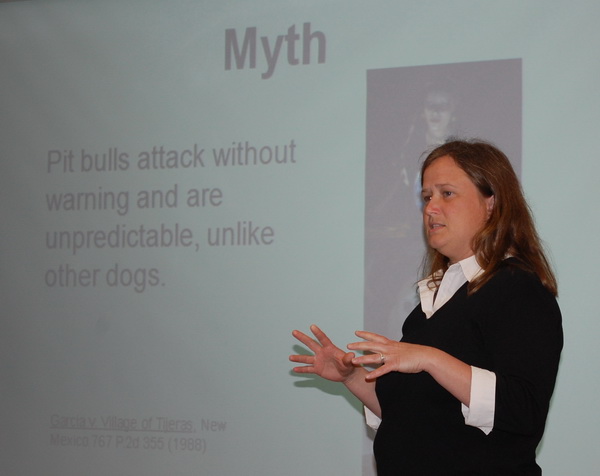
- NCRC’s Kara Gilmore busts the myth about pit bulls being unpredictable and more likely to attack.

Born killers or family pet? How is it that a small group of dogs with similar physical attributes was labeled Pit Bull, and why are the demonized in society? The answer to those questions, according to National Canine Research Council (NCRC) director of communications Donald Cleary and general counsel Kara Gilmore, is simple: availability bias (blowing something that is a rare occurrence into something regular – such as an isolated dog bite becoming an epidemic) leading to outright panic.
Beginning in the 1970s and intensifying in the mid-1980s, pit bulls became the focal point of media attention, and then the target of hungry legislators aiming to take advantage of a social climate where dogs – which are often the victims of animal abuse – were being portrayed as the aggressors, when they are more often simply acting out against their abusers or others.
According to NCRC, seven factors led to the false stereotypes surrounding pit bulls: public attitudes, myths of behavior, media bolstering the negative images (much the way the book Uncle Tom’s Cabin did for Blood Hounds), broad-based view of different dogs being characterized as a single “pit bull” breed, media stimulation of a non-compassionate view, inaccurate academic studies (often relying on unsubstantiated or fabricated information), and political/legislative motivations.
Many people do not know that “pit bull” is not actually a breed of dog, rather a grouping of similar looking dogs – usually American Stafford Terriers and their cousins. Legislation, such as that outlawing pit bulls in Miami-Dade County, has led to much confusion and there is a lot of litigation ongoing now to try and de-stigmatize these animals, which when raised as a family member or pet instead of a fighting animal, are no more or less dangerous than your average poodle. One breed of dog is not more likely to attack, or be more vicious. Dobermans, terriers, poodles, Labradors, dachshunds – they are all dogs, and they all behave differently based on a number of variables. Not unlike humans, who often look and sound different, but we all act differently too. It’s time to kick the pit bull stereotype to the corner.
A copy of Kara Gilmore’s e-book, The Pit Bull Placebo: Media Myths and Politics of Canine Aggression, is available for a free download at: http://nationalcanineresearchcouncil.com/ncrc-publications/
The Animal Legal Defense Fund was born of a bold and singular vision: that the lives and interests of animals in research labs, on farms, in the wild and in our own communities — would one day be recognized and protected by law. That day draws closer. Since 1979, the ALDF has been pushing the U.S. legal system to end the abuse and cruelty visited upon countless millions of animals each year. ALDF has made great strides but has really just begun to make the case for those who cannot speak on their own behalf. For more information about the Animal Legal Defense Fund go to: www.aldf.org

